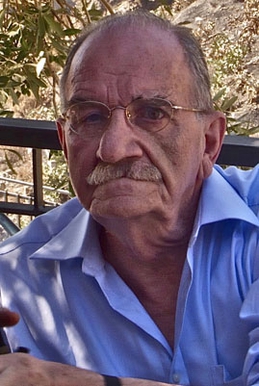Nicholas Ambraseys facts for kids
Quick facts for kids
Nicholas N. Ambraseys
|
|
|---|---|
 |
|
| Born | 19 January 1929 Athens, Greece
|
| Died | December 28, 2012 (aged 83) England
|
| Citizenship | British, Greek |
| Alma mater | Imperial College London National Technical University of Athens |
| Known for | Historical Seismicity, Calculation of seismic displacements of dams |
| Awards | 44th Rankine Lecture (2004) Legend of Earthquake Engineering |
| Scientific career | |
| Fields | Engineering Seismology Soil Mechanics |
| Institutions | Imperial College London |
| Thesis | The seismic stability of earth dams (1958) |
| Doctoral advisor | Alec Skempton Alan W. Bishop |
| Doctoral students | Sarada K. Sarma |
Nicholas N. Ambraseys (born January 19, 1929 – died December 28, 2012) was a smart Greek scientist. He was an expert in seismology, which is the study of earthquakes. He taught at Imperial College London and was known as a top expert in earthquake engineering in Europe. This field focuses on designing structures to withstand earthquakes.
Contents
His Journey in Science
Nicholas Ambraseys first studied engineering in Athens, Greece. After that, he went to Imperial College London to study civil engineering. He focused on soil mechanics (how soil behaves) and engineering seismology. In 1958, he earned his PhD. His main project was about how stable earth dams are during earthquakes.
He started working at Imperial College in 1958. Later, he became a full professor of engineering seismology in 1974. In 1968, he started a special section at the college. This section focused on engineering seismology. He led this group until he retired in 1994. He also helped create the British National Committee of Earthquake Engineering.
What He Studied
Professor Ambraseys spent most of his time studying engineering seismology. He also worked on geotechnical earthquake engineering. This is about how earthquakes affect the ground and structures built on it. He helped figure out how likely earthquakes were to happen. He also designed dams and foundations that could stand strong during quakes.
He wrote over 300 papers and helped start the Journal of Earthquake Engineering. Many people see him as one of the main founders of engineering seismology.
How Earthquakes Affect Dams and Slopes
His early work looked at how stable dams are during earthquakes. He helped create a way to predict how much earth dams might move during a quake. This idea later became known as the Newmark's sliding block method. Other famous scientists, like Nathan Newmark, recognized his important contributions.
One of his first PhD students, Sarada K. Sarma, continued this work. Sarma developed the Sarma method for checking how stable slopes are during earthquakes. Professor Ambraseys's ideas helped many young scientists. They learned how to better understand how the ground moves during an earthquake.
Learning from Past Earthquakes
Professor Ambraseys was very involved in collecting information about strong earthquakes in Europe. He helped create a huge database of earthquake data. This information is now used by many researchers and engineers.
Many people believe his biggest contribution was in historical seismicity. This means studying earthquakes that happened a long time ago. He traveled a lot and looked through old books and writings. He found a lot of information about past earthquakes. He could speak many languages, which helped him find original sources. He was able to correct mistakes in old earthquake records. This helped create more accurate lists of past earthquakes.
In 1985, he used his knowledge of historical earthquakes to make a prediction. He suggested that very large earthquakes (magnitude 6.0 or higher) might not happen in the UK. He wondered if the UK was one of the quietest places for earthquakes.
Other Important Work
He also studied how water forces affect structures. His work on tsunamis was also very important. There is even an intensity scale for tsunamis named after him. It's called the Sieberg-Ambraseys Tsunami Intensity Scale.
Teaching About Earthquakes
Professor Ambraseys was one of the first teachers of earthquake engineering in Europe. He created special courses at Imperial College for students. These courses taught about earthquake engineering and how structures react to quakes. Many talented students from all over the world came to study with him. He inspired many engineers who are now leaders in their fields.
Awards and Recognition
Nicholas Ambraseys received many honors for his work. He was a member of the Royal Academy of Engineering and the Academy of Athens. He also received medals from many scientific groups in the UK and Europe.
In 2005, he received the Harry Fielding Reid Medal. This is the highest award given by the Seismological Society of America. It's given to people who make amazing contributions to seismology and earthquake engineering. Famous scientists like Charles Richter have also received this award.
The European Association for Earthquake Engineering created an award in his honor. It's called the "Prof. Nicholas Ambraseys Distinguished Lecture Award."
In 2008, he was named one of the 13 "Legends of the Field" in Earthquake Engineering. He was the only European on this special list.
After he passed away, Imperial College and other groups held a special event in 2014. It was called the "Nicholas Ambraseys Memorial Symposium." They celebrated his huge impact on earthquake engineering. A special issue of the Bulletin of Earthquake Engineering was also published in his memory.
Books He Wrote
- Ambraseys, N., Melville, C. (1982). A history of Persian earthquakes, Cambridge University Press.
- Ambraseys, N., Melville, C., Adams R. (1994) Seismicity of Egypt, Arabia and the Red Sea, Cambridge University Press.
- Ambraseys, N., Finkel C. (1995) The seismicity of Turkey, Eren Press.
- Ambraseys N., Sigbjörnsson R. (1999) Reappraisal of Seismicity of Iceland, Polytechnica Pub., Reykjavik.
- Ambraseys N., Adams R. (2000) The seismicity of Central America, Imperial College Press.
- Ambraseys N. (2009) Earthquakes in the eastern Mediterranean and the Middle East: a multidisciplinary study of seismicity up to 1900, Cambridge University Press. (ISBN: 9780521872928)

